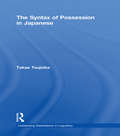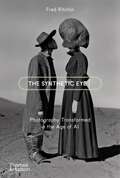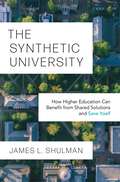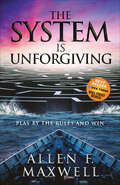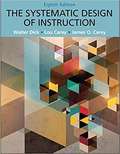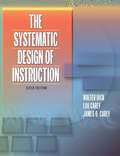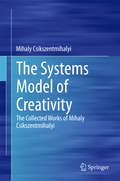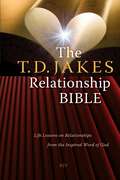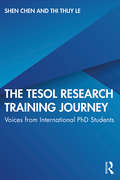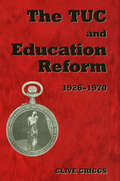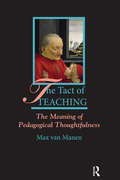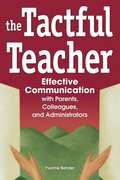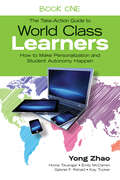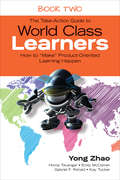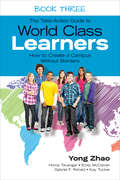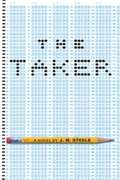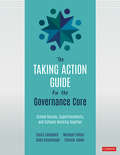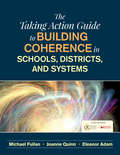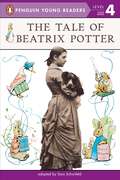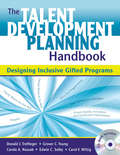- Table View
- List View
The Syntax of Possession in Japanese (Outstanding Dissertations in Linguistics)
by Takae TsujiokaFirst Published in 2002. Routledge is an imprint of Taylor & Francis, an informa company.
The Synthetic Eye: Photography Transformed in the Age of AI
by Fred RitchinA revelatory glimpse into the future of photography, one where the very nature of how images are created is fundamentally transformed by artificial intelligence. An invaluable roadmap in a new world. The revolution caused by artificial intelligence in terms of what a photograph can and cannot do is profound. This book looks at photography’s strengths, what it has meant for individuals and for society, its massive transformations caused by a variety of factors in the digital age, and the newer possibilities for image making. These include old and new media, with an emphasis on synthetic imaging as both a positive and terrifying development. In 1840, a year after photography’s invention, the painter Paul Delaroche exclaimed, “From now on, painting is dead.” Photography was quicker and cheaper as a representational medium and more realistic, its invention also liberated painters to become much more adventurous, embracing approaches that included impressionism, cubism, minimalism, and abstract expressionism. So too photographers are being challenged today. Many have responded with new strategies, but more innovation is needed. Can photographers be as radically expansive and revolutionary as painters were? Can they preserve or even expand the photograph’s role in society as a credible witness? Can the photographic image morph into forms previously unimagined? The Synthetic Eye is about this transformative revolution. How can synthetic imagery be utilized to amplify our understanding of ourselves and our worlds? Can an alternative photography deepen and expand the medium’s previous reach? What are the pitfalls? How will our senses of the real, the possible, and the actual be affected?
The Synthetic University: How Higher Education Can Benefit from Shared Solutions and Save Itself
by James L. ShulmanA bold, collaborative vision for combatting the ever-rising cost of collegeUS colleges and universities have long been the envy of the world. Institutional autonomy has fostered creativity among faculty, students, and staff. But this autonomy means that colleges tend to create their own solutions for every need. As a result, higher education suffers from costly redundancies that drive tuitions ever upward, putting higher education, essential to the fabric of the country, at risk. Instead of wishful thinking about collaboration or miraculous subsidies, The Synthetic University describes intermediary organizations that can provide innovative, cost-effective solutions.Offering answers to challenges jointly faced by thousands of institutions, James Shulman lays out a compelling new vision of how to reduce spending while enabling schools to maintain their particular contributions. He explains why colleges are so resistant to change and presents illuminating case studies of mission-driven and market-supported entrepreneurial organizations—such as the student tracking infrastructure of the National Student Clearinghouse or the ambitious effort of classics professors to create a shared transinstitutional department. Mixing theory with lessons drawn from his own experience, he demonstrates how to finance and implement the organizations that can synthesize much-needed solutions.A road map for sustained institutional change, The Synthetic University shows how to overcome colleges’ do-it-yourself impulses, avoid the threat of disruption, and preserve the institutions that we need to conduct basic research, foster innovation, and prepare diverse students to lead meaningful and productive lives.
The System is Unforgiving: Play by the Rules and Win
by Allen F MaxwellAllen Maxwell’s The System is Unforgiving presents 15 rules that anyone can apply to their current situation for success.
The Systematic Design Of Instruction
by James Carey Lou Carey Walter DickA classic in the field, The Systematic Design of Instruction, 8/e presents a clear introduction to the fundamentals of instructional design―and the concepts and procedures necessary for analyzing, designing, developing, and evaluating instruction for all delivery formats. This is not a textbook to be memorized, but rather a learning-by-doing resource designed to help students create their own sound, effective instruction. In it readers learn a systematic, thoughtful, inquiry-based approach to creation, which in turn helps ensure the success of students in their charge. It features an intuitive chapter organization, an integrated model that presents research carefully illustrated with academic and business applications, contemporary design examples, sample rubrics and exercises, and annotated references. <P><P> This new edition has retained the features that have been most popular and helpful in the previous editions, while adding new perspectives and features that keep the text current, including updated references and recommended readings; additional attention to important topics such as learning and portable digital devices; additional tables summarizing and organizing concepts; a serial case study example which applies the text’s instructional design concepts; an additional case study in the Appendices; a plan with case study examples; and a helpful, easy-to-use Instructor’s Manual.
The Systematic Design of Instruction (Sixth Edition)
by Walter O. Dick Lou Carey James O. CareyThis classic text introduces students to the fundamentals of instructional design and helps them learn the concepts and procedures for designing, developing, and evaluating instruction for all delivery formats. The new edition builds upon the foundation of previous editions with clear discussions on the impact of critical new theories, new technologies, and the Internet. The book addresses current design processes used in instructional settings and delivery systems across many areas of curriculum and business, including Internet-based Distance Education. Hallmark Features *The text clearly describes and models the instructional design process as it is practiced in educational and business settings, allowing students easy transfer of important topics. *The conceptual base for each step in the instructional design model is clearly defined and described in an accessible manner.*Application of and decision-making about instructional design concepts are illustrated through a serial case study example carried through the steps of the design model in each chapter of the book. *Opportunities are provided for readers to apply new concepts through practice and feedback activities at the end of each chapter. *Up-to-date references and recommended readings with annotations allow students to further explore the concepts presented in the text. *This new edition uses course management technology to illustrate design. The new CourseCompass website includes: goals and objectives for each step in the model, illustrations of preinstructional materials, rubrics for evaluating products for each step in the model, concept quizzes, and much more.
The Systems Model of Creativity
by Mihaly CsikszentmihalyiThis first volume of the Collected Works of Mihaly Csikszentmihalyi represents his work on Art and Creativity. Starting with his seminal 1964 study on creativity up to his 2010 publication in Newsweek, the volume spans over four decades of research and writing and clearly shows Csikszentmihalyi's own development as an academic, psychologist, researcher and person. Unconventional and unorthodox in his approach, Csikszentmihalyi chose the topic of creativity as a field of study believing it would help him be a better psychologist and advance his understanding of how to live a better life. The chapters in this volume trace the history of the study of creativity back to the days of Guilford and research on IQ and Jacob Getzels' work on creativity and intelligence. Firmly grounded in that history, yet extending it in new directions, Mihaly Csikszentmihalyi started his life-long study on artistic creativity. His first extensive study at the School of the Art Institute of Chicago enabled him to observe, test and interview fine art students drawing in a studio. The study formed the very basis of all his work on the subject and has resulted in several articles, represented in this volume, on such creativity-related concepts as problem solving versus problem finding, the personality of the artist, the influence of the social context, creativity as a social construction, developmental issues and flow. The main contribution to the topic of creativity and also the main concept explored in this volume, is the Systems Model of Creativity. Seven chapters in this volume discuss the development of this conceptual model and theory.
The T.D. Jakes Relationship Bible: Life Lessons on Relationships from the Inspired Word of God
by T. D. JakesYou are invited to begin a lifelong journey to discovering God's words of truth for your life and relationships, and to discovering God Himself in the words of His Book! From Genesis to Revelation, it is clear that the Holy Bible is, in the words of Bishop T.D. Jakes, "The Greatest Love Story Ever Told." It is not a book about religion, but relationships--from the creation of a man and a woman and their intimate relationship with God in the Garden through the tragic break in that relationship at the Fall and the eventual restoration of that relationship through Jesus Christ and His death on the cross of Calvary. Our relationship with God is the foundation for our lives. If we try to build on any other relationships or things, we are building on quicksand, because at some point all of our relationships will break down. It is from our earthly relationship with God that He gives us the privilege of having healthy relationships with our spouse, our families, our friends, and countless others. *** Inside the pages of God's Word you will discover the divine instruction on life relationships that has been given to generations of people who faced the same issues and questions that you face today, addressing those questions honestly and openly and offering wise counsel for your relationships, inspiration for your needs, comfort for your sorrows, guidance for your confusion, and hope for your discouragement. In The Relationship Bible, you will find the following features from Bishop Jakes: * A 32-page Introduction that sets forth "The Greatest Love Story Ever Told" along with helps to understanding the Bible and guides to answering life's relationship problems. * Reflections of God's Heart--Over 20 pages of articles that continue to develop God's love relationship with mankind. * Lessons of the Heart--Over 80 pages of life lesson articles that address a wide range of relationship issues. * Heartbeats--25 articles that demonstrate how to build relationships. * Heartbreakers--25 articles that demonstrate how relationships are damaged. * Heart Murmurs--10 powerful prayers for your personal relationships. * Words of Jesus in Red * Concordance * One-Year Bible Reading Plan
The TESOL Research Training Journey: Voices from International PhD Students
by Shen Chen Thi Thuy LeResearch training is challenging, and the attrition rate of doctoral students has been increasing in Canada, the UK, the USA and Australia. In their book, Chen and Le examine the reasons for these students becoming demotivated, particularly in the context of TESOL. There has been much investigation into research training issues in multiple contexts and multiple disciplines. Yet, the research training process in TESOL for international students has not been explored sufficiently, and their voices have not been heard. This book gives voice to the research trainees, allowing their experiences to be reflected and the implications discussed in order to help create more effective supervision models. By employing the qualitative approach and adopting critical incident as a new technique for data collection, Chen and Le attempt to gain insights into the research training process to reveal different research stages of research trainees—those undertaking PhD degrees—and to put forward a model of supervision to improve the innovation and quality of research. This book tackles the complex nature of research training. It is hoped that findings of this study can provide research supervisors and trainees with theoretical insights and practical references.
The TUC and Education Reform, 1926-1970 (Woburn Education Series)
by Dr Clive Griggs Clive GriggsThis book covers a crucial period for the development of state education in Britain; the advent of the comprehensive debate before and during the Second World War; the War years themselves and the 1944 Education Act; the post-War Labour Government; and Churchill's last government in a time of education expansion. From the 1960s, the focus shifted to questions of social deprivation and educational opportunities, secondary school selection, the debate on standards, Robbins and higher education, and the continuing theme of the dominance of public schools.The book is divided into four sections, which are then divided into chapters. Each chapter takes as its main reference point a key issue within the chronological framework of the book, e.g. resistance to secondary education for all, politics and textbooks, multilateral and technical schools, pressure groups and the 1944 Education Act, Churchill and the Conservatives. Much new light is thrown on the topics by the author's use of new material and he has made a valuable contribution to the politics of education.
The Tact of Teaching: The Meaning of Pedagogical Thoughtfulness
by Max van ManenIn The Tact of Teaching bestselling author Max van Manen offers teachers at every stage an original and inspiring interpretation of the notion of pedagogy, one that searches for its roots in the experience of in loco parentis. Using dozens of anecdotes and scenes taken directly from life in classrooms, including many from the often-neglected domain of high school, The Tact of Teaching explicates the meaning of pedagogical moments, the conditions of pedagogy, the relation between pedagogy and politics, the nature of pedagogical experience, and the practical forms of pedagogical understanding. The author: -Presents experiential analysis of the relation between pedagogical reflection and action-Explores how pedagogical tact manifests itself, what tact accomplishes, and how tact does what it does-Speaks of hope and humane practice in an era of schooling often given over to mindless technocracy or fashionable despair
The Tactful Teacher
by Yvonne BenderBy equipping teachers with the tools they need to communicate effectively with colleagues, parents, and administrators, this handbook prepares them to deal successfully with and understand the dynamics of a variety of work-related situations. Especially helpful for those new to the field, this guide teaches the skills to build effective communication, tailor messages to fit their recipients, and interact with difficult people and under pressure. Using specific scenarios, such as dealing with angry parents, sharing unpleasant information, or communicating in less-than-ideal school environments, different communication strategies, and why they work, are discussed in detail. Advice is also given on handling "The Social Addiction Trap" and those tricky "what's your opinion" questions with grace and aplomb.
The Take-Action Guide to World Class Learners Book 1: How to Make Personalization and Student Autonomy Happen
by Yong Zhao Homa S. Tavangar Emily E. McCarren Gabriel F. Rshaid Kay F. TuckerYour blueprint to entrepreneur-minded schooling The Take-Action Guide to World Class Learners series provides the most complete information available on designing twenty-first century schools poised to leapfrog into the future! These practice-oriented books expand on Dr. Yong Zhao’s acclaimedWorld Class Learners, which presents a new framework for cultivating creative and entrepreneurial students. Now, with this first book in the follow-up three-volume set, Zhao digs much deeper, revealing how exactly to put that framework into effect. This first book in the series provides specific strategies and practical advice on how to Incorporate student choice for flexible, student-focused curriculum Motivate students to turn strengths into passions Cultivate students’ technical, creative, decision making, and communication skills Implement Zhao’s new paradigm shift one phase at a time, starting with Book 1. Better yet, read all three volumes for a complete blueprint to entrepreneur-minded schooling. "The ideal school should provide opportunities and resources to enable students to personalize their educational experiences instead of receiving a uniform standardized, externally prescribed, education diet." --Yong Zhao
The Take-Action Guide to World Class Learners Book 1: How to Make Personalization and Student Autonomy Happen
by Yong Zhao Homa S. Tavangar Emily E. McCarren Gabriel F. Rshaid Kay F. TuckerYour blueprint to entrepreneur-minded schooling The Take-Action Guide to World Class Learners series provides the most complete information available on designing twenty-first century schools poised to leapfrog into the future! These practice-oriented books expand on Dr. Yong Zhao’s acclaimedWorld Class Learners, which presents a new framework for cultivating creative and entrepreneurial students. Now, with this first book in the follow-up three-volume set, Zhao digs much deeper, revealing how exactly to put that framework into effect. This first book in the series provides specific strategies and practical advice on how to Incorporate student choice for flexible, student-focused curriculum Motivate students to turn strengths into passions Cultivate students’ technical, creative, decision making, and communication skills Implement Zhao’s new paradigm shift one phase at a time, starting with Book 1. Better yet, read all three volumes for a complete blueprint to entrepreneur-minded schooling. "The ideal school should provide opportunities and resources to enable students to personalize their educational experiences instead of receiving a uniform standardized, externally prescribed, education diet." --Yong Zhao
The Take-Action Guide to World Class Learners Book 2: How to "Make" Product-Oriented Learning Happen
by Yong Zhao Homa S. Tavangar Emily E. McCarren Gabriel F. Rshaid Kay F. TuckerYour blueprint for product-oriented learning The World Class Learners series provides the most complete information available on designing twenty-first century schools poised to leapfrog into the future! These practice-oriented books expand on Dr. Yong Zhao’s acclaimed World Class Learners, which presents a new framework for cultivating creative and entrepreneurial students. Now, with this second book in the follow-up three-volume set, Zhao digs much deeper, revealing how exactly to put that framework into effect. The second book in the series outlines how to Understand entrepreneurship and project-oriented learning Implement "making-as-learning" POL curriculum Help students create quality entrepreneurial products Understand ownership, copyrights, and patents Implement Zhao’s new paradigm shift one phase at a time, starting with any book, depending upon your priorities. Better yet, read all three volumes for a complete blueprint to entrepreneur-minded schooling. "The ideal school should provide opportunities and resources to enable students to personalize their educational experiences instead of receiving a uniform standardized, externally prescribed, education diet." -Yong Zhao
The Take-Action Guide to World Class Learners Book 2: How to "Make" Product-Oriented Learning Happen
by Yong Zhao Homa S. Tavangar Emily E. McCarren Gabriel F. Rshaid Kay F. TuckerYour blueprint for product-oriented learning The World Class Learners series provides the most complete information available on designing twenty-first century schools poised to leapfrog into the future! These practice-oriented books expand on Dr. Yong Zhao’s acclaimed World Class Learners, which presents a new framework for cultivating creative and entrepreneurial students. Now, with this second book in the follow-up three-volume set, Zhao digs much deeper, revealing how exactly to put that framework into effect. The second book in the series outlines how to Understand entrepreneurship and project-oriented learning Implement "making-as-learning" POL curriculum Help students create quality entrepreneurial products Understand ownership, copyrights, and patents Implement Zhao’s new paradigm shift one phase at a time, starting with any book, depending upon your priorities. Better yet, read all three volumes for a complete blueprint to entrepreneur-minded schooling. "The ideal school should provide opportunities and resources to enable students to personalize their educational experiences instead of receiving a uniform standardized, externally prescribed, education diet." -Yong Zhao
The Take-Action Guide to World Class Learners Book 3: How to Create a Campus Without Borders
by Yong Zhao Homa S. Tavangar Emily E. McCarren Gabriel F. Rshaid Kay F. TuckerYour blueprint for nurturing globally connected students! Help your students learn for, with, and from anyone, anywhere in the world. This powerful resource from respected expert Dr. Yong Zhao helps educators at all levels build a globalized learning environment that fosters students’ cultural and entrepreneurial competencies. This third volume in Zhao’s three-book set outlines how to: Transform students into strong, responsible global citizens Leverage experts, networks, and partner school relationships Implement a “glocalized” Global Campus or classroom Upgrade your school or classroom. Use this practical guide to build a world-class education for your students!
The Take-Action Guide to World Class Learners Book 3: How to Create a Campus Without Borders
by Yong Zhao Homa S. Tavangar Emily E. McCarren Gabriel F. Rshaid Kay F. TuckerYour blueprint for nurturing globally connected students! Help your students learn for, with, and from anyone, anywhere in the world. This powerful resource from respected expert Dr. Yong Zhao helps educators at all levels build a globalized learning environment that fosters students’ cultural and entrepreneurial competencies. This third volume in Zhao’s three-book set outlines how to: Transform students into strong, responsible global citizens Leverage experts, networks, and partner school relationships Implement a “glocalized” Global Campus or classroom Upgrade your school or classroom. Use this practical guide to build a world-class education for your students!
The Taker
by J. M. SteeleCarly Biel's future is right on track: she's a great student (mostly A's and B's); her boyfriend, Brad, is captain of the lacrosse team; and she's a shoe-in for Princeton (her dad's an alum - love that legacy status!). She's never been great at standardized tests (so nerve-racking!), but she always figured she'd do well enough on the SAT to get by. Guess what? She tanks. Really tanks. Now she only has one more opportunity to take the test, and she's sure she can't pull her scores up by much. That's why, when she gets a mysterious note from "The Taker," she can't resist. Now she's hired someone to take the test for her - but what if she gets caught? And what if she doesn't?
The Taking Action Guide for the Governance Core: School Boards, Superintendents, and Schools Working Together
by Michael Fullan Davis W. Campbell Babs Kavanaugh Eleanor AdamPractical resources for building cohesive governance teams As a supplement to the best-selling The Governance Core, this practical guide will help trustees and superintendents adopt a governance mindset and partnership that creates coherence throughout the district. With a systems thinking approach, the authors provide readers with the strategies and tools needed to build cohesive teams and engage in deeper learning and decision making. The Taking Action Guide for the Governance Core offers readers: • a deeper understanding of core governance and how to build it • a planning guide to help new trustees get started • protocols and sample agendas for focusing on strategy and systems during open board meetings Educational leaders will find this guide offers them a foundation for building strong, flourishing school districts that are equipped to adapt to and meet the daunting challenges of our time.
The Taking Action Guide for the Governance Core: School Boards, Superintendents, and Schools Working Together
by Michael Fullan Davis W. Campbell Babs Kavanaugh Eleanor AdamPractical resources for building cohesive governance teams As a supplement to the best-selling The Governance Core, this practical guide will help trustees and superintendents adopt a governance mindset and partnership that creates coherence throughout the district. With a systems thinking approach, the authors provide readers with the strategies and tools needed to build cohesive teams and engage in deeper learning and decision making. The Taking Action Guide for the Governance Core offers readers: • a deeper understanding of core governance and how to build it • a planning guide to help new trustees get started • protocols and sample agendas for focusing on strategy and systems during open board meetings Educational leaders will find this guide offers them a foundation for building strong, flourishing school districts that are equipped to adapt to and meet the daunting challenges of our time.
The Taking Action Guide to Building Coherence in Schools, Districts, and Systems
by Michael FullanGet there faster: Your road map to smart, sustainable change! Taking Action is a hands-on guide to the groundbreaking book, Coherence: The Right Drivers in Action for Schools, Districts and Systems, providing step-by-step protocols to help foster deep coherence for maximum student learning—all within a reasonably short time frame. You’ll develop: Deeper understanding of The Coherence Framework A 100-Day Coherence Plan Leadership, capacity, and coalition-building skills Systems and tools to assess your organization Includes video links, print resources, case studies, and diagnostic and planning tools. Fostering greater coherence is at your fingertips with this instant action guide!
The Taking Action Guide to Building Coherence in Schools, Districts, and Systems
by Michael FullanGet there faster: Your road map to smart, sustainable change! Taking Action is a hands-on guide to the groundbreaking book, Coherence: The Right Drivers in Action for Schools, Districts and Systems, providing step-by-step protocols to help foster deep coherence for maximum student learning—all within a reasonably short time frame. You’ll develop: Deeper understanding of The Coherence Framework A 100-Day Coherence Plan Leadership, capacity, and coalition-building skills Systems and tools to assess your organization Includes video links, print resources, case studies, and diagnostic and planning tools. Fostering greater coherence is at your fingertips with this instant action guide!
The Tale of Beatrix Potter (Penguin Young Readers, Level 4)
by Penguin Young ReadersLearn all about the creator of Peter Rabbit and celebrate Beatrix Potter's 150th birthday on July 28, 2016!Born to a wealthy family in Victorian London, Beatrix Potter never had many playmates. When she got lonely, she turned to the animals in her playroom: rabbits, mice, frogs, hedgehogs... even a snake! From an early age, she was a talented painter, and she published her art as a young woman. Her dream of becoming a children's book author, though, didn't come true until she was in her mid-thirties. After writing a letter about four little bunnies to a friend's son, Beatrix created The Tale of Peter Rabbit. The story was turned down several times but was finally picked up by Frederick Warne & Co. Beatrix spent the rest of her life in the countryside, painting, drawing, farming, and protecting the land she loved so much.
The Talent Development Planning Handbook: Designing Inclusive Gifted Programs
by Donald J. Treffinger Grover C. Young Carole A. Nassab Edwin C. Selby Carol V. Wittig"Makes a distinct contribution to program planning for gifted education. Provides great charts that illustrate the key basics for identifying change." —Tara McGuigan, Resource Teacher San Diego Unified School District, CA "The major strength of the book is its step-by-step process. There are plenty of charts and checklists that make the book user-friendly. Great planning guide." —Cheryl Brockman, Gifted Education Teacher Jonathan Alder Local School District, Plain City, OH Gain tools to custom-build programs that nurture students' strengths and talents! Gifted programs should be as innovative, unique, and ever-evolving as the exceptional students they serve. This comprehensive handbook provides the expert guidance and tools necessary for shaping a contemporary, inclusive talent development program tailored to students' individual needs and strengths. Rather than imposing a "one-size-fits-all" model, this guide offers a flexible six-stage framework for planning, implementing, evaluating, and enhancing gifted programs. The authors draw on current theory, research, and more than 20 years of professional experience with schools, districts, and state education agencies to provide proven approaches for designing new programs and reinvigorating existing ones. Practical tips and ready-to-use resources include: A CD-ROM with reproducibles, presentations, and templates aligned with each chapter Needs assessment and climate inventory exercises and resources Methods for constructing and implementing action plans Strategies for tackling logistics, including how to form planning committees and effectively lead the planning process Program goal-setting and evaluation tools Ideal for gifted education coordinators, administrators, and special education directors, The Talent Development Planning Handbook covers best practices from leading experts to inspire innovation, improvement, growth, and change for talent development that contributes to the total school program.
